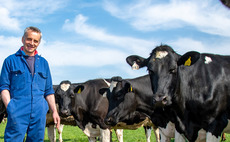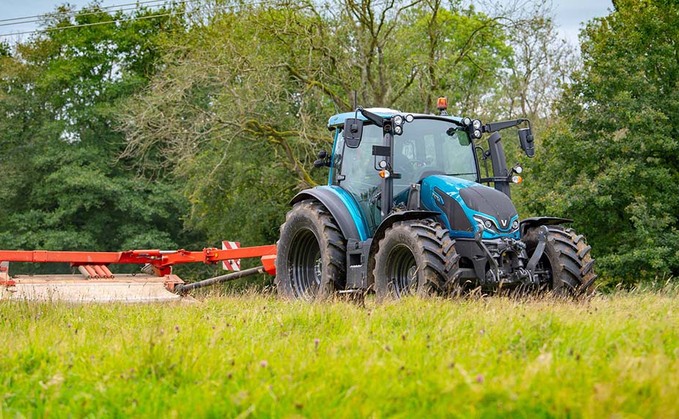
Representing a much coveted segment of the tractor market among tractor manufacturers, we test drive Valtra's latest G Series addition. James Rickard puts the new contender to work.
As discovered with our recent test drives of New Holland's T5 Dynamic Command and John Deere's 6M Series tractors, the 100-140hp tractor market is a highly desirable place to be for manufacturers.
It is a demanding segment to be in as well, with tractors having to match up to the hugely diverse nature of its customer base, from simple, low-spec tractors for yard work, to machines specced with all the bells and whistles, affording precision farming tasks.
Keen to capitalise on this segment, Valtra recently introduced its brand new G Series, slotting neatly in between its simple A Series and its higher-spec N Series. Within the G Series range there are four models from 105 to 135hp (rated power) and like its bigger brothers there are various specification levels to choose from; HiTech, Active and Versu. These primarily relate to differences in controls and hydraulic performance.
To delve deep into the tractor's capabilities, we test drove the series flagship, the G135, complete with the firm's top-spec Versu package and a mind bending wealth of optional extras, courtesy of the manufacturer's Unlimited Studio. In addition, the tractor was equipped with a colour-matched factory-fitted loader.
In reality, our extravagant test spec is unlikely to make it onto most British and Irish farms, but it did show just how far you could go with the spec on this tractor.
To give the tractor a good workout, we gave it a fortnight's worth of silaging duties to carry out including mowing, raking, round baling and bale shifting.
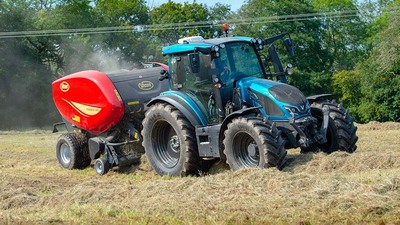
Specifications
- Model: Valtra G135 Versu Unlimited
- Maximum rated power: 135hp
- Maximum boosted power: 145hp
- Maximum torque: 560Nm
- Transmission: 40kph, 24 by 24 speed, semi-powershift
- Rear linkage lift capacity: 6,000kg (5,000kg through whole lift range)
- Front linkage lift capacity: 3,000kg
- Hydraulic pump capacity: Load sensing, 110 litres/minute
- Wheelbase: 2,550mm
- Price: Range starts from £73,100 (G135 Versu Unlimited as tested: £109,000)
Engine and transmission
Engine and transmission 1

Common to all G Series models is the use of a 4.4-litre, four-cylinder Agco Power engine and a Gima-built 24 by 24 speed semi-powershift transmission. The latter is a well proven unit, used extensively throughout sister brand, Massey Ferguson's tractor range for many years, as well as in Claas' range of Arion tractors.
Though still a bit ‘tight', due to newness, the engine came across as a strong performer, despite being a little ‘flat' below 1,700rpm. Once ‘loaded up' though, the engine came into its own. This became particularly apparent on the fixed chamber round baler, with some dense swaths and several gradients to tackle.
Engine and transmission 2
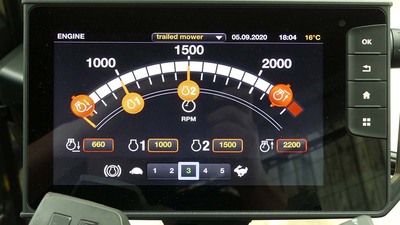
Transmission-wise, it is made up of four ranges with six powershift gears in each. On top of manual control, the transmission also features two automatic modes. Mode one sees the tractor work out for itself which gear it needs to be in, while mode two allows you to tailor the upshift and downshift points. All of this can be done through the Versu's terminal, which allows you to customise the tractor to the job or your preferences.
While you can set a PTO cruise speed in auto and use either the drive lever or pedal to alter forward speed like a CVT tractor, for our PTO-powered jobs manual was generally used, giving total control over engine and transmission. It was more for some of our transport work and bale shifting, where the auto modes came into their own.
For draft work, we can see the auto modes being useful, whereby you can set a target speed and leave the tractor to work out the revs and the ratios to achieve that speed.
Engine and transmission 3
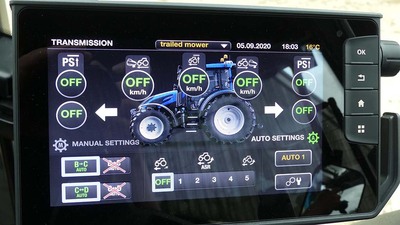
Other features include ‘Auto Traction' whereby you can stop and start the tractor using the brakes only, without having to use the foot clutch. As we found, this is ideal for loader work and great for stop/start work like round baling. And when combined with the automatic transmission, you can almost drive the tractor like an automatic car.
‘Hill Hold' is another useful feature which, as the name suggests, holds the tractor on a hill, allowing you to just use the throttle pedal to move off, without having to manage the clutch and brakes. It is handy for when pulling away from a set of traffic lights, for example.
Like all tractors in this segment, the G Series is limited to 40kph, which for some may be disappointing, but it does do it with economy in-mind. As such, 40kph can actually be achieved in the top three gears, with the highest gear able to achieve 40kph at just 1,640rpm.
Cab
Cab 1
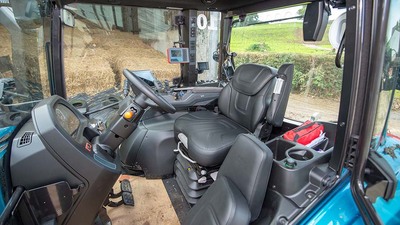
Though the G Series shares its cab frame with the smaller A Series, windscreen glass area is actually a touch larger, due to the cab being sat up higher. Along with the G Series' generously sloped bonnet, sightlines to the loader are also very good - there are not many tractors now where you can clearly see a loader's headstock when hooking up to an attachment.
This good visibility extends all around and upwards, particularly helped by an almost full width roof window.
As for access, step lights help you find your way in the dark and the route to the cab is unhindered, with a straight line from the steps to the seat - there is nothing you have to weave around and squeeze between.
On our Unlimited model, you are greeted by swathes of soft black leather which adorns the seats and steering wheel. Along with the carpet, it really gives a premium feel to a ‘small' tractor.
Cab 2
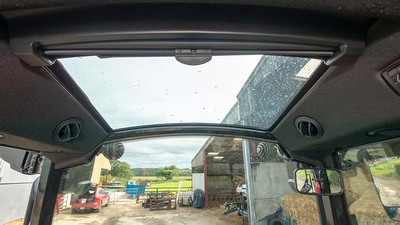
In-cab storage space is pretty good too, better than a lot of larger tractors. There are several deep pockets on the left side of the cab and a decent one on the right, along with a varied wealth of power sockets and a good sized phone holder.
There are also lots of vents dotted around the roof line, ideal for getting air flow where you need it.
While inside noise levels are reasonable, sound quality could be better; a harsh metallic drone was very noticeable in the cab when the tractor was working hard on the round baler.
Mechanical cab suspension and front axle suspension can be specified, as it was on our tractor. This did a good job overall at ironing out the bumps, especially highlighted during the high speed mowing duties and when carrying bales with the loader across fields - the loader's boom suspension also helping a lot with this.
Controls
Controls 1
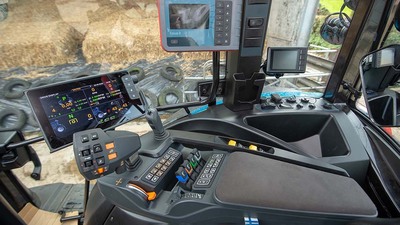
Standard on the top-spec Versu model is the firm's SmartTouch control interface featuring electric spool control, a main multifunction control lever for all primary controls, a secondary joystick taking care of various assignable functions and a nine inch touch screen terminal for all set-up and monitoring. Buttons and switches, such as diff, 4WD and engine memory, are neatly recessed into the armrest, with frequently used buttons raised ever so slightly for quick location. The armrest is almost minimalistic in appearance with little clutter.
As we have found in previous Valtra test drives, SmartTouch's simplicity and clarity makes it a pleasure to use.
However, if Versu spec is a little over the top for your needs, you can choose the entry level HiTech spec or the mid-spec Active options. Both of these come with Valtra's ‘basic' control layout, offering simpler control with less features and mechanical spools. Setting up things like the transmission can then be done through the dash.
Controls 2
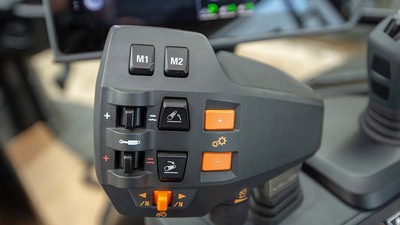
Both Versu and Active spec are guidance-ready. While Versu can use its integrated screen for guidance control, Active requires either a third party screen or Valtra's own SmartTouch Extend screen specifying. The latter is essentially the same screen as used on the Versu model, but not integrated into the armrest.
Versu models can also be fitted with this ‘Extend' screen, which allows greater monitoring of functions, especially if you find the standard screen too small.
Loader control on this series is electric joystick only. Despite our reservations over such a small ‘stick to control the loader, it actually turned out to be very precise, affording good proportional control over hydraulic functions. This joystick can also be used to control the front linkage and hydraulic services.
Hydraulics and PTO
Hydraulics and PTO 1
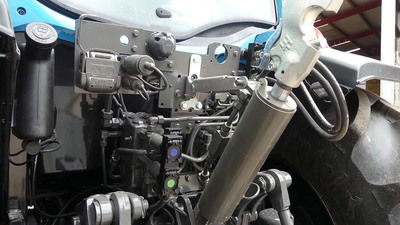
When it comes to hydraulics, the G Series is not found wanting. At the rear, up to four electrically-controlled or three mechanically-controlled double-acting spools can be specified. With either option, a standard, on/off electric spool is always included to control the push back pick up hitch.
However, with spool number two set further back than spool one and being so close to the top link, it is more awkward to get at. This said, with a normal top link and without the diverter valve to the front linkage (incorporated into spool one), space around spool two would be better.
Load-sensing, hydraulic pump capacity is a decent 110 litres/minute on the Versu. This is the same for the Active model, but if you wanted something simpler, a 100 litre/minute gear pump is a feature of the HiTech version of the G Series.
However, if you are a fan of separate hydraulic and transmission reservoirs, as found on the Ns and Ts, the G Series makes do with a shared system. It is not necessarily a bad thing, more something to be aware of when it comes to oil hygiene.
Hydraulics and PTO 2
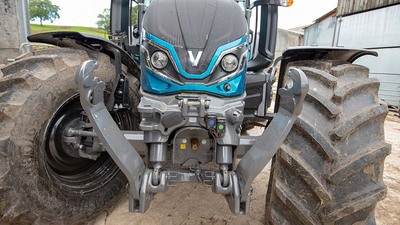
PTO speeds are plentiful, offering more speed selection than the Ns and Ts. This includes 540, 540E, 1,000 and 1000E. There is also the option of a ground speed PTO.
Rear mudguard controls are the same as the Ns and Ts, with buttons for linkage, spool number one and PTO control.
Up-front, hydraulic services are generous, with mid-mount valves allowing control over the front linkage and two, double-acting spools. A fourth feed can also be diverted from one of the rear valves to the front, effectively giving a third set of double-acting spools. A front IsoBus socket can also be specified.
Practicalities
Pick-up hitch light
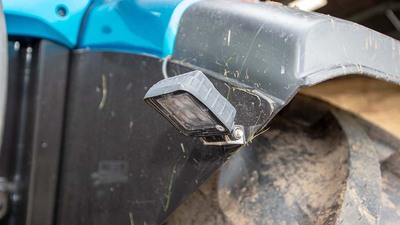
A neat touch at the rear is the inclusion of an LED pick-up hitch light.
Lighting
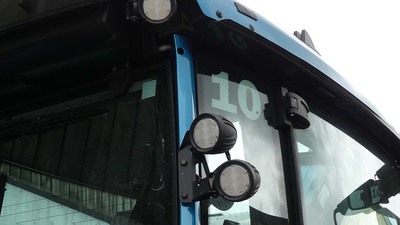
Lighting is very effective on the G Series, with several options to choose from.
Steps
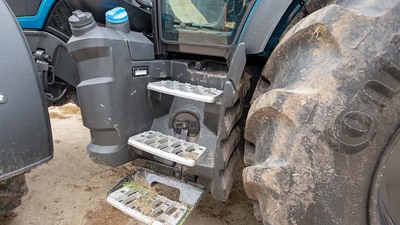
Aluminium tread plates should prove more durable than steel.
Oil levels
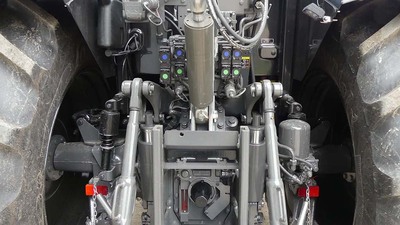
A rear sight glass allows quick checks of back-end oil level.
Toolbox
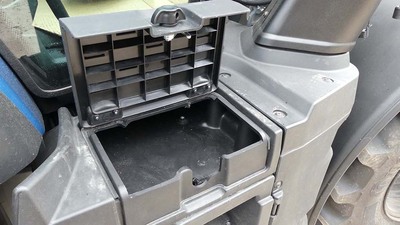
An ample-sized toolbox has been integrated into the right hand side of the tractor.
Radiators
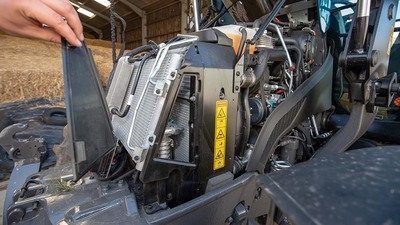
While radiators do not fold out, there is a small removable side hatch to help cleaning.
Chassis
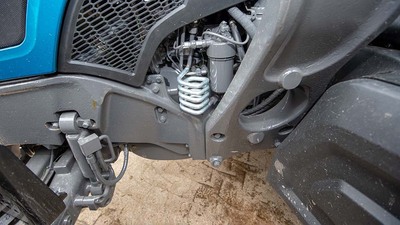
A wasp-shaped chassis allows for a tight steering lock and a 4,360mm turning radius.
Loader
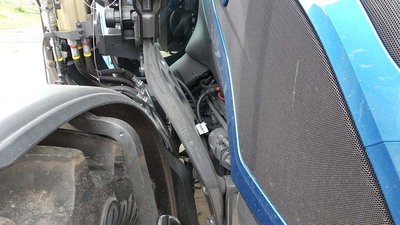
Loader brackets can be directly bolted onto the chassis.
Verdict
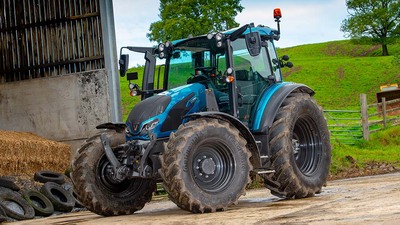
As it was intended to do, the G Series fits perfectly in between the A and N Series. And while we got a flavour of the highest specification possible, its flexible options list should please a diverse range of customers.
In terms of operation, it is very much like driving one of Valtra's larger tractors. Most impressively, though, is how the firm has managed to squeeze so many features into what is a relatively compact package.
Overall, the G Series should satisfy many potential customers in this segment, but as we are finding, there is some seriously tough competition in this segment.

















